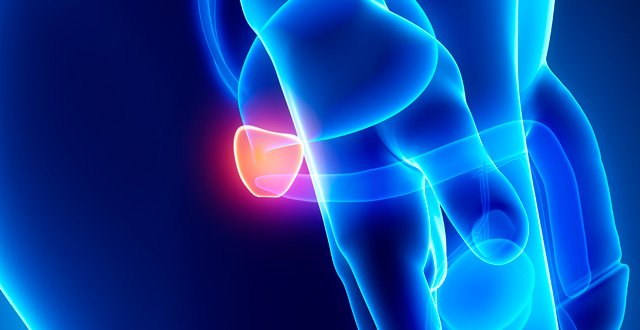Prostate cancer incidence in Ireland is currently one of the highest rates in Europe
Irish statistics show that one-in-seven men will be diagnosed with prostate cancer in their lifetime. Excluding non-melanoma skin cancer, prostate cancer is the leading cause of cancer in men internationally. It accounts for 30 per cent of all newly-diagnosed cancers in Irish males and 11 per cent of all invasive cancers in Ireland. The National Cancer Registry Ireland (NCRI) estimates annual average incidence to be 3,665 patients in the period 2017 to 2019. In terms of mortality, from 2014 to 2016, prostate cancer accounted for 525 deaths annually, making it the third-most common cause of cancer death (just over 11 per cent of the total cancer mortality).
Trend data from the NCRI shows significantly increasing prostate cancer incidence, with around 1,000 cases per year in the early 1990s, to over 3,600 in 2017. These increases have, in part, been due to the use of opportunistic screening using the prostate-specific antigen (PSA) test to diagnose prostate cancer at an earlier stage, which led to the diagnosis of many indolent cancers that may not have presented symptomatically during the man’s lifetime.
With improving treatment, a changing disease profile and a changing patient demographic, five-year survival has increased significantly, from 66 per cent for patients diagnosed from 1994-1998, to 93 per cent for those diagnosed from 2011-2015 (NCRI).
The presentation of prostate cancer
PSA is a protein made solely by prostate cells, so the antigen is highly specific for the prostate.
PSA testing has revolutionised prostate cancer screening since the 1990s. Although originally introduced as a tumour marker for the detection of cancer recurrence, it became widely adopted as a screening tool for prostate cancer. However, it is not prostate cancer-specific and other prostate conditions, such as benign prostatic hyperplasia (BPH) or prostatitis, can affect PSA levels.
Statistics suggest that almost 80 per cent of men currently diagnosed with prostate cancer undergo a biopsy because of a suspicious PSA. However, it is not untypical for men presenting with a normal PSA to subsequently be diagnosed with prostate cancer. Local symptoms of prostate cancer may include bladder outlet obstruction, such as nocturia, hesitancy or pain on passing urine, incomplete emptying and a diminished urinary stream. Bone pain may be the presenting symptom in men with metastatic disease, but an initial diagnosis when bone metastases are present has become unusual. However, in many cases, these reflect benign conditions, such as BPH, rather than malignancy.
Digital rectal examination (DRE) retains an important role for early detection and diagnosis of prostate cancer.
Risk factors for prostate cancer
Increasing age is the most important risk factor for prostate cancer. In Ireland, the majority of cases are detected in men aged 65-to-84 years, with 37 per cent detected in men <65 years of age. Family history is associated with an increased risk of developing prostate cancer: Men with a father or a brother diagnosed with prostate cancer at age 50 years have an approximately two-fold increased risk of prostate cancer. Asian men are less likely to develop prostate cancer, whereas black men have the highest incidence of prostate cancer of any group (231.9 per 100,000). Obesity has been associated with higher-grade prostate cancers, possibly as a result of altered hormone levels. Studies have shown increased risk associated with various dietary intakes, including high levels of high-saturated fats and red meats and reduced intake of fish, fruit and vegetables (ie, tomatoes).
Pathophysiology
High-grade prostatic intraepithelial neoplasia (PIN) is the histological entity widely considered to be the most likely precursor of invasive prostatic cancer. PIN is characterised by cellular proliferation within pre-existing ducts and glands with cytological changes.
Prostate cancer tends to spread along the capsular surface of the prostate gland and may invade the seminal vesicles, peri-prostatic tissue, eventually leading to bladder invasion. Subsequent spread can be to the perineural spaces, lymphatics and blood vessels, which may result in haematogenous metastases.
Bone metastases are very common in patients with prostate cancer. With the benefit of early diagnosis, most prostate cancers tend to be localised at diagnosis, with limited evidence of spread beyond the pelvis.
Treatment
Current management of prostate cancer involves a multidisciplinary approach, with input from primary care, radiology, pathology, urology, radiation oncology and medical oncology. Management depends on the presentation of prostate cancer: Early/localised cancer, locally-advanced cancer, biochemical failure (rising PSA in the absence of metastatic disease), hormone-sensitive metastatic disease, and hormone-refractory metastatic disease.
Treatment options for patients with prostate cancer include active monitoring, radical prostatectomy, external beam radiotherapy, and brachytherapy. Hormone therapy (androgen deprivation or anti-androgens) is the primary treatment for metastatic prostate cancer, but is also increasingly being used for patients with locally-advanced, non-metastatic disease. In patients with localised prostate cancer, the choice of treatment is guided by whether the disease is considered low, intermediate, or high risk.
In patients with low-risk, localised prostate cancer, and those deemed to have an intermediate risk who decline radical treatments (prostatectomy or radiotherapy), active monitoring is a suitable option. This involves checking PSA levels every three months and a DRE every six months for the first year. DREs are continued six-monthly thereafter, but the frequency of PSA monitoring decreases. A biopsy should be completed at the end of year two and every three years thereafter.
No trigger factors for conversion to active treatment have been validated to date. However, there is broad agreement around a rapidly-rising PSA, Gleason score progression, increased tumour volume, DRE changes and patient preference being potential trigger factors for escalating to radical treatment from surveillance. Radical prostatectomy can be considered as a treatment option for patients with low-grade, right up to high-grade, prostate cancers.
In patients with intermediate-risk or high-risk localised prostate cancer (when there is a realistic prospect of long-term disease control) and in those with locally-advanced disease, radical prostatectomy or radical radiotherapy should be offered.
Robotic-assisted radical prostatectomy is now by far the commonest method used in the surgical treatment of prostate cancer, and its use continues to increase in Ireland.
Other treatment options include a combination of radical radiotherapy and androgen deprivation therapy, consisting of six months of androgen deprivation therapy (ADT) before, during or after radiotherapy.
ADT involves the use of a luteinising hormone-releasing hormone (LHRH) agonist (buserelin, goserelin, leuprorelin acetate or triptorelin), or bilateral orchiectomy, which removes the supply of endogenous hormone. LHRHs suppress testicular function by inhibiting luteinising hormone and FSH secretion from the pituitary. These therapies may be continued for up to three years in patients with high-risk, localised prostate cancer. Initial treatment with LHRH may result in a ‘disease flare’, ie, initial rise in LH leading to increased levels of testosterone and temporary deterioration in the patient’s status. This is prevented by the use of an anti-androgen (usually cyproterone acetate) starting three-to-five days before the start of treatment and continued until testosterone levels have reached optimum levels (usually three-to-four weeks in total).
Side-effects
It is important to note that ADT is associated with a wide range of side-effects, many of which impair quality-of-life. Although these side-effects are potentially significant, they should not preclude the use of ADT in appropriate clinical settings. Side-effects that are important to highlight when providing patient counselling include:
Loss of lean body mass, increased body fat, and decreased muscle strength.
Fatigue.
Behavioural changes.
Sexual dysfunction — loss of libido generally develops within the first several months and is followed by erectile dysfunction.
Osteoporosis, which may be compounded by the presence of bone metastases.
Hot flushes due to vasomotor instability.
Gynaecomastia, decreased body hair, and reduced penile and/or testicular size.
Cardiovascular/metabolic abnormalities.
Bilateral orchiectomy should be offered to all patients with metastatic prostate cancer as an alternative to continuous LHRH agonist treatment. Anti-androgen monotherapy with bicalutamide or enzalutamide may be offered to those who are willing to accept the adverse impact on overall survival and gynaecomastia in the hope of retaining sexual function. Anti-androgens act as competitive androgen receptor antagonists. They are usually administered in combination with LHRH analogues or surgical castration. If they are used as monotherapy, testosterone levels may rise (due to androgen blockade in the hypothalamic and pituitary glands). These agents are not associated with an initial disease flare.
Men with prostate cancer will eventually show evidence of disease progression, despite castration. In these patients, secondary hormonal manipulations, including the addition of, or switching to, a different anti-androgen (flutamide, bicalutamide, nilutamide, enzalutamide), addition of androgen synthesis inhibitors (abiraterone (+ prednisolone)), or use of an oestrogen, such as diethylstilbestrol (DES), can be considered.
Abiraterone has been found to improve radiographic progression-free survival (16.5 months with abiraterone-prednisone and 8.3 months with prednisone alone) and significantly delay clinical decline and initiation of chemotherapy in patients with metastatic, castrate-resistant prostate cancer. In a double-blind phase 3 study conducted in 2014, 1,717 patients were assigned to receive either enzalutamide (at a dose of 160mg) or placebo once daily. The study was stopped after a planned interim analysis showed a benefit of the active treatment. The rate of radiographic progression-free survival at 12 months was 65 per cent among patients treated with enzalutamide, as compared with 14 per cent among patients receiving placebo. Increasingly, it is being demonstrated that for men with castration-resistant prostate cancer whose disease has progressed on or after a docetaxel-based chemotherapy regimen, there is strong clinical data supporting the efficacy of abiraterone (+ prednisone) or enzalutamide.
For men with castration-resistant prostate cancer and bone metastases, treatment with zoledronic acid or denosumab should be considered to lower the risk of skeletal-related events.
References on request
Additional reporting by Priscilla Lynch
It should be noted that the five-alpha reductase inhibitors finasteride and dutasteride will lower PSA levels and may mask PSA elevation secondary to prostate cancer. Finasteride lowers PSA levels by a median 50 per cent within six months of use and dutasteride has been reported to reduce PSA levels by 48 to 57 per cent.













Leave a Reply
You must be logged in to post a comment.